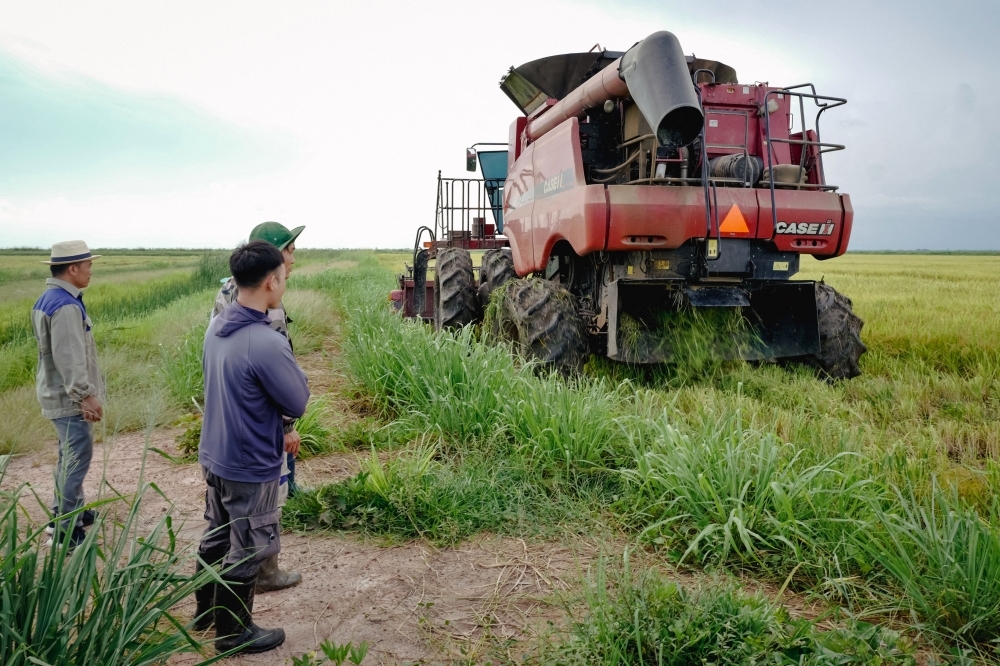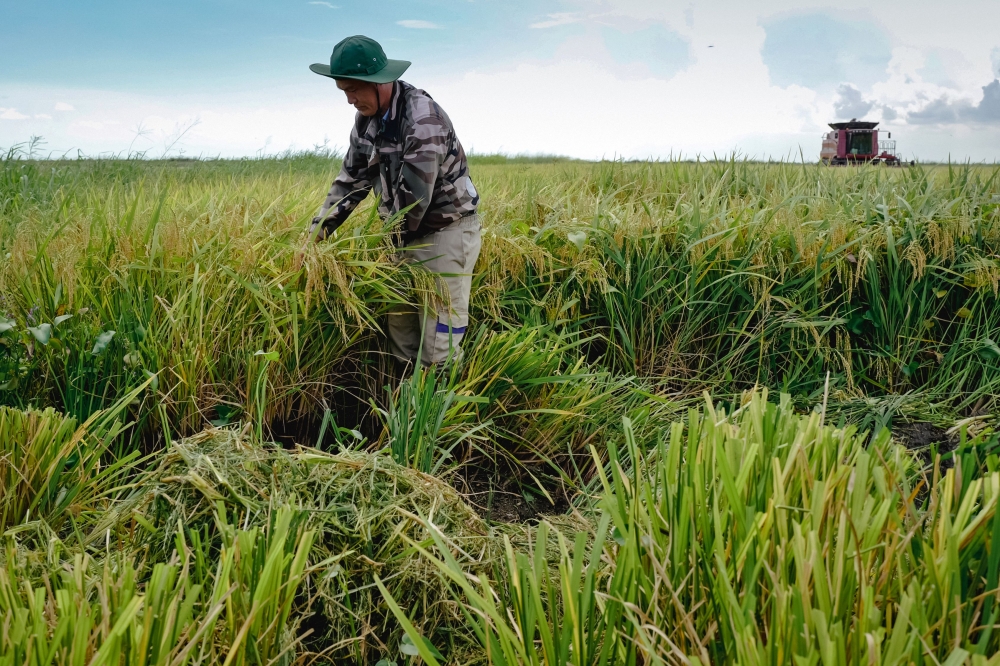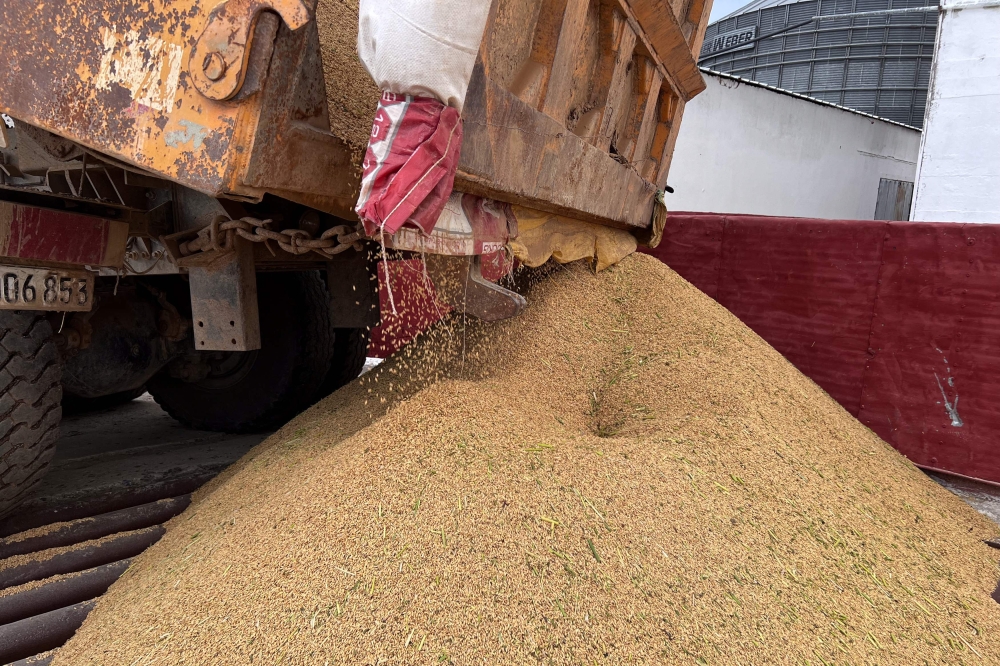
From Hanoi to Havana: Cuba turns to Vietnamese expertise to tackle food shortages and attract investment

Vietnamese rice specialists watch mechanized rice harvesting, in Los Palacios, Pinar del Rio province, Cuba May 29, 2025. The Cuban government gave land to a private Vietnamese company for rice production in the face of the lack of local productive varieties and inputs to solve the lack of this cereal on the island. — AFP pic
Sunday, 17 Aug 2025 7:00 AM MYT
LOS PALACIOS (Cuba), Aug 17 — Outside Havana, a combine belonging to a private Vietnamese company is harvesting rice, directly farming Cuban land — in a first — to help address acute food shortages in the country.
The Cuban government has granted Agri VAM, a subsidiary of Vietnam’s Fujinuco Group, 1,000 hectares of arable land in Los Palacios, 118 kilometres west of the capital.
Vietnam has advised Cuba on rice cultivation in the past but this is the first time a private firm has done the farming itself.
The government approved the move after a 52 per cent plunge in overall agricultural production between 2018 and 2023, according to data from the Centre for the Study of the Cuban Economy at the University of Havana.
The rice numbers are even worse. Total rice production dropped from 300,000 tons in 2018 to 55,000 tons in 2021, in the depths of the Covid pandemic. The number is slowly recovering, authorities say.
Rice is a staple of the local diet, with Cubans consuming 60 kilos of rice per person per year.

A Vietnamese specialist checks the quality of grains during the mechanized harvesting at a Vietnamese rice field in Los Palacios, Pinar del Rio province, Cuba May 29, 2025. The national average rice yield is 1.6 tonnes per hectare, and the first fields harvested within this plan had a yield exceeding six tonnes per hectare. — AFP pic
Promising yields and daunting obstacles
During a media visit to its rice fields in May, an Agri VAM representative said the harvest yield to date is seven tons per hectare, “but we want more.”
That number dwarfs the ton and a half yield-per-hectare of Cuban growers.
Vietnam experienced the kind of food shortages that Cuba is going through now, in the 1980s. Today, the South-east Asian country is the world’s third exporter of rice and a valued consultant to other rice-growing nations.
“The climate and the temperature are very good for agriculture,” but Cuban growers lack necessary farming products such as fertilisers, the Agri VAM representative told reporters.
Though Agri VAM can import some materials, it faces other obstacles such as fuel shortages, transportation problems and frozen assets, Cuban economist Omar Everleny Perez and other sources with knowledge of the situation told AFP.
Agri VAM and other foreign firms in Cuba may be making profits but “they cannot transfer them abroad because the banks have no liquidity, no foreign currency,” Perez said.
An independent Cuban media outlet, 14ymedio, recently published excerpts of a letter dated in May, in which Agri VAM asked the Cuban government to unfreeze US$300,000 (RM1.2 million) in its account at state-owned International Financing Bank.
Vietnam’s state press in May quoted deputy agriculture minister Nguyen Quoc Tri asking the government in Havana “to eliminate investment barriers that Vietnamese companies encounter.”
AFP contacted Agri VAM and Cuban officials but got no response.

A truck unloads Vietnamese rice in an industrial dryer, in Los Palacios, Pinar del Rio province, Cuba May 29, 2025. — AFP pic
Foreign investment: Badly needed
Cuba is mired in an acute economic crisis and desperately in need of foreign investment. Vietnam and other allies have shown interest.
In July, Cuban Prime Minister Manuel Marrero Cruz announced that Havana was taking measures “to energise foreign investment” as he authorised “wholly foreign-owned companies” in the hotel sector.
After three years of promises, Russia’s deputy prime minister Dmitry Chernyshenko announced in May that Russian businesses want to invest US$1 billion in Cuba. Moscow will give them preferential financing rates, he said.
But he cautioned that there is “still hard work to be done” and said it is “impossible to achieve things immediately, as if by magic.” — AFP
What happened to the Cuban socialist paradise ?
ReplyDeleteHEAVILY SANCTIONED BY A WICKED NATION
DeleteI paraphrase your Buddy CCP idiot on this
Delete"A small country must know its place in the scheme of geopolitical manipulations.
Playing to the tune of spurious ideological USSR/Russsia (host to USSR Ballistic missiles 3 minutes. From American shores) is a known disaster falling right infront of its fate.
Cuba can easily avoiding such fate by staying neutral in the game of USSR /Russia westward expansion to threaten the Wankees.
Cuba for all her wants, acts as the sacrificial lamb in a losing & exhausting war for the puppeteers of the USSR / Russia geopolitical play.
That fate is WELL deserved!"
Well, well, well mfer say that to Ukraine lah.
Delete& don't forget to add that Russia has only acted militarily when all his patience in negotiating for a way out with Ukraine is lost!
In addition to Cuba role as Russian puppet proxy during the Cuban missile crisis, Cuba sent armed mercenary "volunteers" all over the world during the 1970s and 1980s to support Soviet Russian sponsored insurgencies throughout the world.
DeleteUSA lost its patience with Cuba long ago, but DID NOT invade or bomb Cuba nor carried out any lethal kinetic action against Cuban soil.
Bay of Pigs action was carried out by irregular Cubans opposed to the Castro regime.
and who sponsored, planned, agitated Bay of Pigs?
Deletethis selective know-nothing mfer, conveniently ignored the fact that the Cuban missile crisis was initiated by the US placing strategic nuclear missiles in Turkey and Italy.
DeleteWhy not From Sekinchan to Kedah? The rice yield in Sekinchan is 4 to 5 times that in Kedah.
ReplyDeleteIf the Northern farmers adopt the methods of Sekinchan, with NO INCREASE in acreage Bolehland will be more than self sufficient.
Muda farmer working attitude is well know & they r well maintained by the full govt subsidies.
DeleteSekinchan generally has a higher rice yield per hectare compared to the Muda area. Sekinchan is known for producing up to 12 tonnes of rice per hectare, while the Muda area, while a major rice production region, averages around 5.3 tonnes per hectare.
ReplyDeleteSekinchan:
High Yields:
Sekinchan is renowned for its high rice yields, often exceeding 10 tonnes per hectare and sometimes reaching 12 tonnes.
Specific Practices:
This high yield is attributed to specific rice-growing techniques and management practices adopted in Sekinchan.
National Recognition:
Sekinchan's success has led to its rice-growing model being adopted in other areas to boost overall rice production.
Muda:
Major Production Area:
The Muda area, under the Muda Agricultural Development Authority (MADA), is a significant rice-producing region in Malaysia.
Lower Average Yield:
While a large-scale producer, the average rice yield in the Muda area is lower compared to Sekinchan, with an average of 5.3 tonnes per hectare.
Extensive Area:
The Muda area covers a large rice cultivation area, but its yield per hectare is not as high as Sekinchan's.
In summary: Sekinchan's success in rice farming is primarily due to its higher yields per hectare compared to the Muda area, despite the Muda area being a major rice production region in Malaysia.